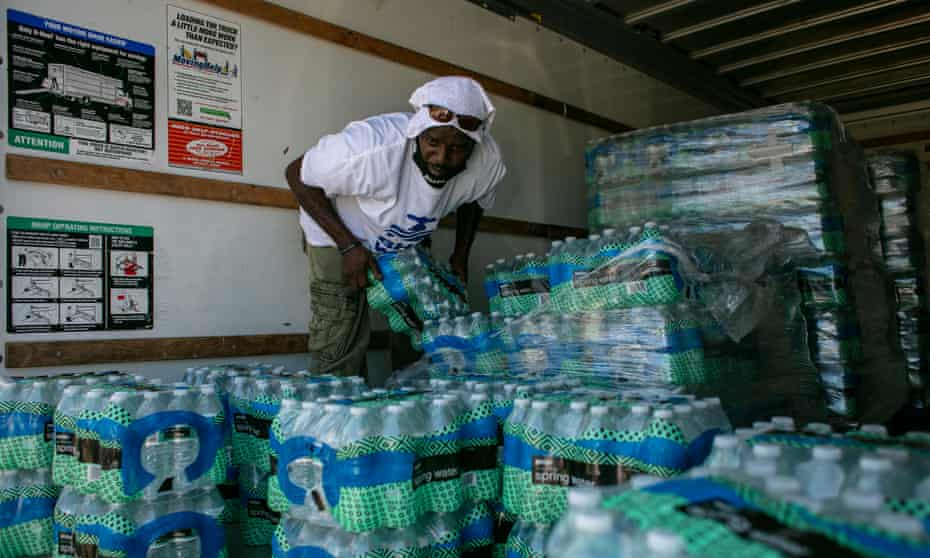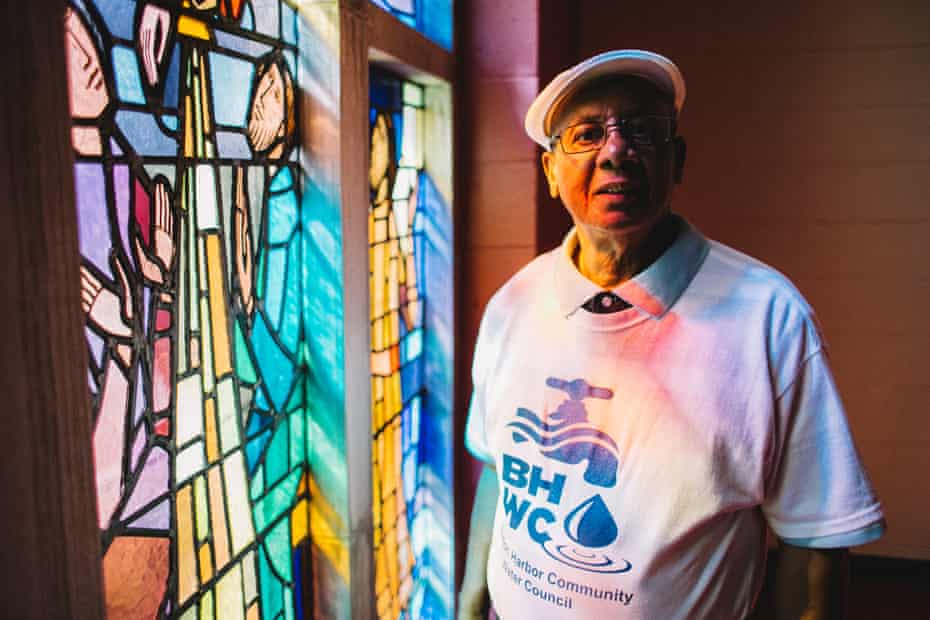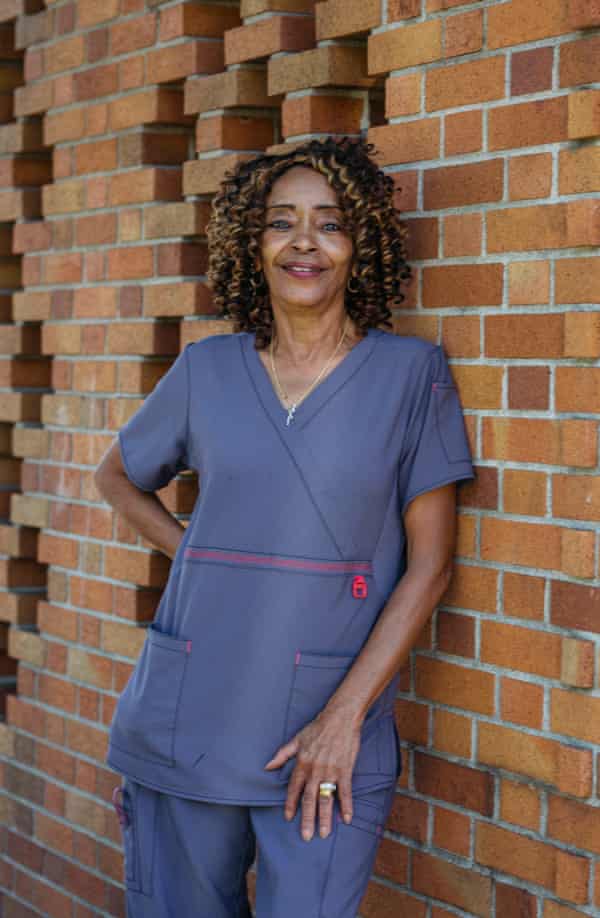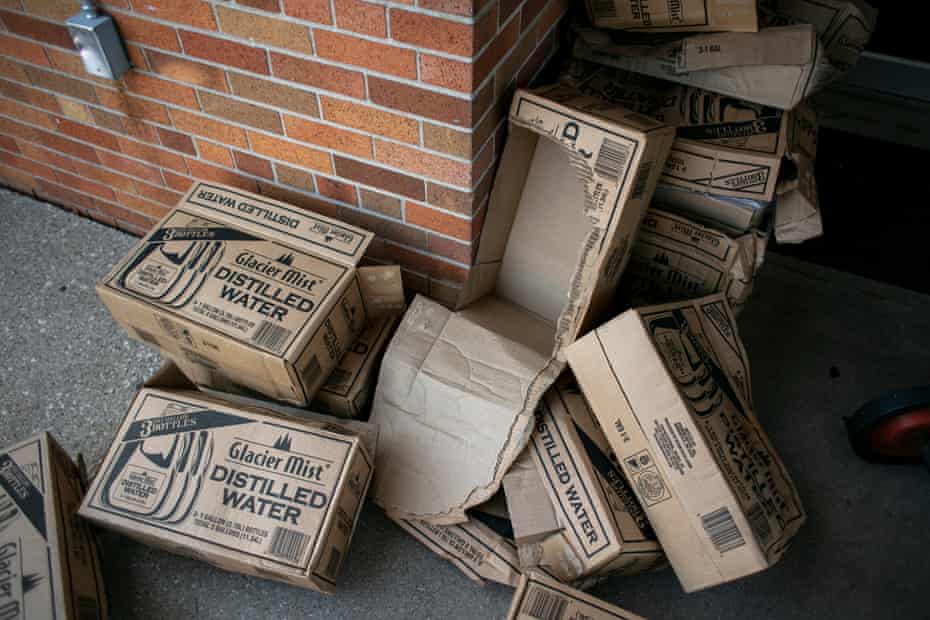A Black town’s water is more poisoned than Flint’s. In a white town nearby, it’s clean

Activists in Benton Harbor say it’s been an uphill battle getting the city, county and state to take action
Last modified on Tue 21 Sep 2021 05.19 EDT
Bobbie Clay first realized something was wrong a few years ago.
The water at her Benton Harbor, Michigan, home had started coming out of the tap looking “bubbly and whitish”. When she filled a glass with it, she could see matter floating around inside. “I became very concerned,” she recalled in a recent interview.
She wasn’t alone. For years, residents of this small, struggling city in south-west Michigan had been having similar problems. When Carmela Patton turned on her sink to make coffee, the water came out brown. When Emma Kinnard ran hers, it came out the color of tea and “sizzling like Alka-Seltzer”. Rasta Smith said his water looked normal, but had a “horrible” taste and a smell that reminded him of rotting sewage. “It’s bad, man,” he said. “It’s real bad.”

Some immediately began buying bottled water and encouraging friends and family to do the same. Others would continue to use the tap water for years and, in many cases, still do. When residents raised questions and concerns, they said, officials in the city and county were unresponsive.
Finally, in 2018, they found out what was going on: tap water samples tested that summer revealed lead levels of 22 parts per billion – well over the federal lead action level of 15 parts per billion and higher, even, than the 20 parts per billion nearby Flint averaged at the height of the crisis that made that city a national symbol of environmental injustice.
But for the last three years, neither the city of Benton Harbor, the county, nor the state have taken sufficient action, according to an emergency appeal filed recently by the National Resources Defense Council (NRDC). The petition, which calls on the US Environmental Protection Agency to address the crisis and assist residents in the meantime, states that lead levels have consistently tested well above the federal action limit, with recordings as high in some samples as 889 parts per billion – nearly 60 times the action limit.
The health risks posed to the residents of this mostly Black, poverty-stricken city -which also happens to be the corporate headquarters of Whirlpool – are extraordinary. Children with lead poisoning tend to have lower IQs, high rates of attention deficit disorder, poor memory and a lack of impulse control. As they become adults, they are also at higher risk for kidney disease, stroke and hypertension. Studies have also connected lead exposure to incarceration for violent crime.
“It’s like they don’t care,” Clay said of the government inaction. “It feels crazy.”
Local activists, led by the Rev Edward Pinkney, president of the Benton Harbor Community Water Council, have mobilized to fill the gaps they say have been left by institutions and local officials, working to raise awareness of the crisis among the city’s 10,000 residents, to advocate on their behalf and to ensure access to bottled water and filters.

In the absence of government solutions, Pinkney believes the work he and others are doing are just “bandages” on the problem. “You’re still gonna bleed,” he told the Guardian. “The lead is still gonna be there.”
There is no level of lead that is considered safe for human consumption. Pinkney’s advocacy did help secure a rare win: Michigan’s Governor Gretchen Whitmer this month proposed $20m to replace the city’s century-old lead pipes, provide water filters to families and make infrastructure improvements in the community. “Every Michigander deserves access to safe drinking water,” Whitmer said in a statement, “and every community deserves lead-free pipes.”
But Pinkney questioned whether Whitmer, a Democrat, could deliver on the proposal with a Republican-controlled legislature, and said in a press conference with the NRDC and other groups petitioning the EPA that even more significant – and urgent – action would be needed to address the city’s water emergency in full.
“We need safe water now,” Pinkney said. “We cannot wait.”
‘Where do you begin?’
The story of Benton Harbor is a story of political dysfunction, institutional abandonment and systemic inequalities that have been amplified to near cartoonish levels.
Situated along the coast of Lake Michigan, the city sits just north of Harbor Country, a collection of bucolic towns popular among vacationing Chicagoans. Neighboring St Joseph, with its quaint downtown, bills itself as the “Riviera of the Midwest”, and is the home town of the influential Upton family, owner of the Whirlpool Corporation.
The twin cities are practically photo-negatives of one another: Benton Harbor is 85% Black; St Joseph is about 85% white. In Benton Harbor, more than 45% of residents live below the poverty line; cross the bridge into St Joseph and the poverty rate is just 7%, well below the state average. And while Benton Harbor has struggled for years with lead-contaminated water, those problems have not appeared to plague its neighbor.
“All the cities around us got good clean water and we don’t,” said Clay, who recalled her children marveling about the water in St Joseph after she picked them up from classes there once. “They say, ‘Momma, this water here is so good,’ and I’m like, ‘This is crazy.'”
“It’s devastating to see that,” she added.

Among residents, there is a prevailing sense that the problems that have been allowed to persist in impoverished, predominantly Black Benton Harbor would have been solved immediately if they were taking place in whiter, wealthier St Joseph.
“If it were St Joe, it would be getting done,” said Mary Alice Adams, a Benton Harbor city commissioner. “And it would be getting done damn fast.”
That it hasn’t in Benton Harbor, despite lead contamination far higher than the level set by the EPA, is due to the demographics of the city, some activists say. “Our health conditions are due to racism,” said the Rev Dr Don Tynes, a community activist and chief medical officer at the Benton Harbor Health Center, where he says he has seen the effects of lead contamination in his patients. “We need immediate relief.”
Locals describe a twofold problem in getting that relief: the county has “failed the community”, in the words of Pinkney, while the city government, which made national headlines a decade ago when the state-appointed emergency manager suspended the powers of elected officials, is beset by dysfunction. (Emergency management, which Adams describes as “the great takeover” of Benton Harbor, ended in 2016.)
The mayor of Benton Harbor, Marcus Muhammad, city manager, Ellis Mitchell and water superintendent, Michael O’Malley, did not return the Guardian’s request for comment for this story. The EPA also did not respond to a request for comment.
“It’s hurtful,” said Carmela Patton, who has been a resident for 43 years but has come to believe that the only way to give her children a “fair chance” is to move. “You can’t talk to your city officials. You can’t talk to your mayor. It’s like, where do you begin? … Me personally, I’m ready to go. I’m ready to leave now.”
‘Make it make sense’
To some residents here, that’s exactly the point.
Concerns about gentrification in Benton Harbor have accelerated over the last decade, with the opening in 2010 of Harbor Shores – the Jack Niklaus-designed lakefront golf club that has hosted the Senior PGA Tour Championship four times – and of the shiny new office campus for the appliance giant Whirlpool on the St Joseph River in 2012.

Founded by Louis Upton, patriarch of the family that includes the model Kate Upton and Republican congressman Fred Upton, Whirlpool is a controversial presence in Benton Harbor.
Some here have viewed the jobs it has provided and the investments it has made in the city as essential to revitalizing the community. But to others, including Pinkney, who has been waging a bitter battle against the corporation for nearly two decades, Whirlpool is turning Benton Harbor into something of a company town, while the Black population that has been here since the Great Migration is being forced out. “It’s coming,” Pinkney said of gentrification, as he drove through a development of large, lakeside homes near the golf course. “It’s just a matter of time.”
That golf course, built on land that had been part of one of the oldest public parks in the state, and the Whirlpool campus can seem a world away from the vacant lots, dilapidated homes and housing projects that dominate the rest of this city. But all of it is packed into the same four-square-mile tract of land – an uncanny juxtaposition that, for longtime residents, can seem to intensify the feelings of institutional abandonment.
“It’s sad,” said Adams, the commissioner, who believes that lead-contaminated water exacerbated her late daughter’s seizures. “This is America. We’ve already been deprived and red-lined out of the American dream. Is fresh drinking water, the thing that’s life, too much to ask? Make it make sense.”
‘No end in sight’
Dean Scott, a spokesperson for Michigan’s department of environment, Great Lakes, and energy, said in a statement that the state was working with the city to bring it into compliance with the state’s clean water laws and to “minimize any potential health impacts” on residents in the meantime. Scott said there had been progress: the city has been installing corrosion control treatment technology, “begun the process” of replacing 6,000 service lines, and is now “sampling twice as many homes as it did previously and has increased the testing frequency to every six months instead of every three years”.
Residents, community leaders and environmental groups say more needs to be done – both to address the existing crisis in Benton Harbor and to prevent future water emergencies nationwide.
The NRDC estimates that as many as 12.8m lead pipes and service lines still connect homes to water in all 50 states. While contamination can often be held at bay by treating water with chemicals to keep lead from leaching out of pipes, environmentalists worry that this stopgap measure could become less effective as the country’s infrastructure continues to age. “Drinking water won’t be safe until the country pulls the millions of lead pipes out of the ground found in every state,” Erik Olson, senior strategic director for health at the NRDC, told the Guardian in July.
Making lead pipes a thing of the past could stave off future crises – but the harm in Benton Harbor has already been felt. Attorney Nick Leonard of the Great Lakes Environmental Law Center, which worked with the NRDC to draft the emergency appeal to the EPA, said in a press conference with Pinkney on 9 September that, based on what the city has done, “it could be several more years” before the problem is fixed.
“There’s seemingly no end in sight,” Leonard said, noting that delays in Benton Harbor are especially disturbing because it is an environmental justice community where residents may be exposed to other pollutants and have poor access to healthcare.
In the EPA petition, the NRDC, the Benton Harbor Community Water Council and 18 other groups said the water in Benton Harbor posed an “imminent and substantial endangerment to public health” and called on the EPA to act now to resolve it. The petition also demanded federal intervention – including through education, technical assistance and an “immediate source of safe drinking water”. Referring to the NRDC’s demands on federal resources, Leonard said at the 9 September press conference: “that is what we expect.”
In the meantime, community activists continue to work toward solutions themselves.
The day after filing the emergency appeal, Pinkney hosted a bi-monthly water giveaway in the parking lot of his church – a proud, dark-brick building overlooking the neighborhood on Pipestone Street.

It was a warm September afternoon, and the seemingly inexhaustible reverend was in good spirits, shouting greetings through the windows of residents’ cars as volunteers loaded jugs of Glacier Mist water into their trunks. By the end of the day, he and his volunteers had distributed 500 gallons to residents, along with gift bags that included Nalgene water bottles adorned with a logo designed by Rasta Smith, a Benton Harbor graphic artist who says he has been working to raise awareness of water contamination in the city for the last eight years.
“I’m just excited to be able to do this,” Pinkney said during a pause in the procession, smiling behind his Black Voters Matter mask. “It’s a beautiful feeling.”
Inside the church, Bobbie Clay’s 19-year-old son, Shon, took a short break.

He serves as vice-president of the Benton Harbor Community Water Council. He’s also a student at Lake Michigan College who studies art. The smell of the water in this town he was born and raised in, he said, reminds him of the oil paints he uses sometimes.
“It’s absolutely terrible,” he said.
He and others in the community are doing their best to help, but “it is frustrating,” he acknowledged: without action from those in power, his group could only do so much.
“We feel like we’re on our own … like we have to fix the problem ourselves,” Clay said. “It’s gonna take more than what we’re doing outside, for sure.”

